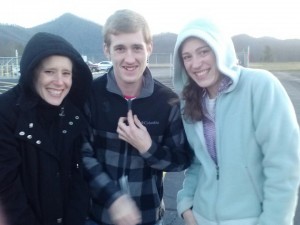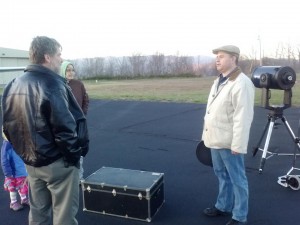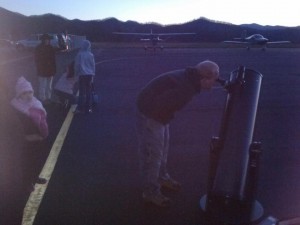Have you ever looked up at the shimmering night sky and formed lingering questions about the universe, the planets, and the constellations that you simply didn’t understand?
WCU’s “Star Party” event gave you a chance to ask those questions and get some answers, as well as gave a chance to see some amazing things in the clear night sky, albeit with the naked eye or with the help from some pretty powerful telescopes.
WCU’s Star Party was held the night of April 5 atop Airport Road in Cullowhee. It was hosted by professors and fellow astronomers Dr. Enrique Gomez and Dr. Paul Heckert. Heckert is a veteran of WCU scholars who is currently in his twenty-fifth year with the university. Dr. Pattie Foley is in charge of organizing the N.C. Science Festival and was also present for the party.

Dr. Pattie Foley (left), David Russell (center), and Sofia Lilly (right) awaiting the stars arrival.
The Star Party was the first event of the N.C. Science Festival of 2013. It featured two very large and very powerful telescopes operated by Gomez and Heckert. Gomez’s telescope was a man operated telescope where as Dr. Heckert’s was controlled by a computer. The two professors even exchanged in a friendly “man vs. machine” event to see which of the two could find an object first.
There were families, children, students, and teachers on deck of the airport runway as Gomez welcomed everyone to the Star Party. He had handouts that mapped out the night sky to help anyone who was interested in locating the constellations easily.
The organizers were able to answer many questions from their grown -up and not so grown up audience. I asked Gomez if there were any ‘Messier objects’ that could be seen with the naked eye. (Messier objects are a set of astronomical objects first listed by French astronomer Charles Messier in 1771.) Gomez explained that the Andromeda galaxy is one of the several Messier objects we can see without help, otherwise known as Messier 31, or M-31.
“The funny thing about Messier,” Heckert added, “Is that the man was only interested in comets. He would look up at something and if it wasn’t a comet, he would log it into his journal as something that he wasn’t interested in paying attention to because it wasn’t what he was looking for. He made the list because he wanted to be able to ignore these objects, which is kind of ironic considering how much we use his list today.”
As the night grew darker, the open sky offered its first image – the planet Jupiter. Everyone began forming lines at the telescope to enjoy their magnified image. More and more stars began to surface in the sky, and one of them had a red tint to it. Someone thought it was Mars, but Gomez clarified.
“That is actually a star that goes by the name of Betelgeuse,” Gomez answered. “It’s red color actually displays the temperature of the star to be much cooler than a star that is bright white in color.”
Gomez went on to talk about the amount of time it actually takes for the light of a star to reach our eyes (some stars are millions of light years away) and said that looking at a star is kind of like looking into the past. The children began booming at the thought of looking back in time.
The comet Pan-STARRS went too low below the horizon too quickly before the night arrived for either of the telescopes to catch a glimpse.
Gomez feels there are many things we can gain by looking at the constellations.
“Part of it is the history. You get to have this connection with cultures from all over the world and you have constellations that are depicted in caves from thirty thousand years ago. (Looking at the stars) connects you to all the places throughout the world and throughout history because essentially we are all and were all looking at the same thing.”
The Star Party saw a great turnout and was a fun and exciting way to kick off the N.C. Science Festival of 2013 that is happening this weekend, April 13.
Below is some video footage of the event.







